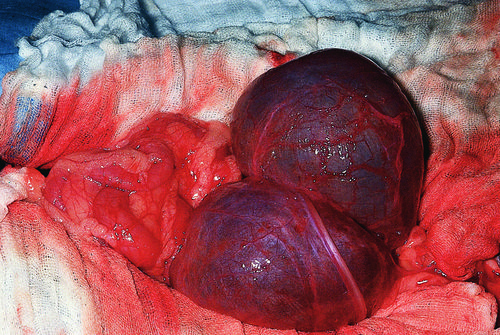Difference between revisions of "Small Animal Soft Tissue Surgery Q&A 03"
Ggaitskell (talk | contribs) |
|||
| (One intermediate revision by the same user not shown) | |||
| Line 1: | Line 1: | ||
| + | {{Template:Manson | ||
| + | |book = Small Animal Soft Tissue Surgery Q&A}} | ||
| + | |||
| + | |||
[[File:SmAn ST Sx 03.jpg|centre|500px]] | [[File:SmAn ST Sx 03.jpg|centre|500px]] | ||
| Line 12: | Line 16: | ||
Periprostatic cyst. <br> | Periprostatic cyst. <br> | ||
The size of the cyst and the absence of communication with the prostate make this the most probable diagnosis. | The size of the cyst and the absence of communication with the prostate make this the most probable diagnosis. | ||
| − | |l1= | + | |l1=Prostatic and Paraprostatic Cysts |
|q2=What anatomic structure is thought to be involved in this process? | |q2=What anatomic structure is thought to be involved in this process? | ||
|a2= | |a2= | ||
Periprostatic cysts are thought to arise from the uterus masculinus, a remnant of the Müllerian duct system. <br><br> | Periprostatic cysts are thought to arise from the uterus masculinus, a remnant of the Müllerian duct system. <br><br> | ||
Serosal cysts and hemorrhage can also result in periprostatic cyst formation. | Serosal cysts and hemorrhage can also result in periprostatic cyst formation. | ||
| − | |l2= | + | |l2=Prostatic and Paraprostatic Cysts |
|q3=What are the surgical treatments for this abnormality, and what are the advantages and disadvantages of each? | |q3=What are the surgical treatments for this abnormality, and what are the advantages and disadvantages of each? | ||
|a3= | |a3= | ||
| Line 29: | Line 33: | ||
*The stoma usually closes spontaneously by eight weeks postoperatively. | *The stoma usually closes spontaneously by eight weeks postoperatively. | ||
*Biopsy of the prostate and cyst wall and castration are performed at the time of resection or marsupialization to identify neoplasia and prevent recurrence of prostatic disease by inducing involution. | *Biopsy of the prostate and cyst wall and castration are performed at the time of resection or marsupialization to identify neoplasia and prevent recurrence of prostatic disease by inducing involution. | ||
| − | |l3= | + | |l3=Prostatic and Paraprostatic Cysts#Treatment |
</FlashCard> | </FlashCard> | ||
Latest revision as of 12:10, 19 October 2011
| This question was provided by Manson Publishing as part of the OVAL Project. See more Small Animal Soft Tissue Surgery Q&A. |
The figure shows an eight-year-old male dog at exploratory surgery. The mass adjacent to the bladder was thin walled and filled with clear yellow fluid. There were several adhesions to the prostate, but an anatomic communication with the gland was not identified.
| Question | Answer | Article | |
| What is the most likely diagnosis? | Periprostatic cyst. |
Link to Article | |
| What anatomic structure is thought to be involved in this process? | Periprostatic cysts are thought to arise from the uterus masculinus, a remnant of the Müllerian duct system. |
Link to Article | |
| What are the surgical treatments for this abnormality, and what are the advantages and disadvantages of each? | Cysts resection is curative if the origin is identified. Disadvantages include more extensive prostatic manipulation needed to identify the origin of the cyst and recurrence in the case of inadequate resection. A recent report described good success using omentalization of the cyst remnant after subtotal resection.
Disadvantages include difficulty in mobilizing the cyst to reach the abdominal wall and prolonged drainage.
|
Link to Article | |
